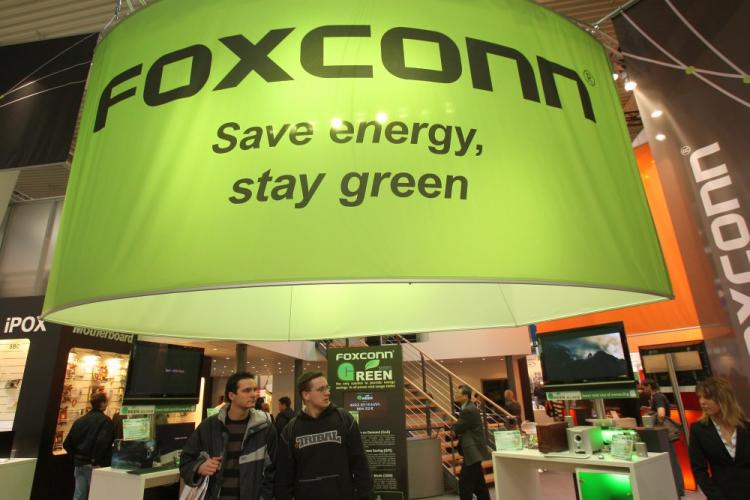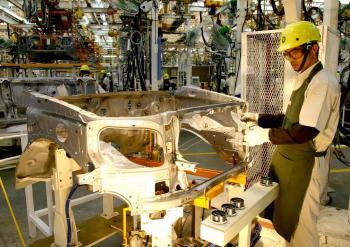The move was prompted in part to keep labor costs down and maintain the company’s footing as the world’s largest contract manufacturer of electronic goods. The factory is owned by Gutaihua Precision Electronics Co. Ltd., a Foxconn subsidiary.
Production at the Zhenzhou facility began on August 2, 2010. Chinese media reported that the first production line employs about one thousand workers: 544 were transferred from Foxconn’s Shenzhen plant and 300 were local hires. Once the factory is in full swing, more than 8,000 workers will be employed.
By the end of 2011, there will be about 200,000 employees working in the Zhengzhou plant, according to deputy general manager, Lin Zhenghui. Construction of a new facility began recently, with its targeted completion date being August 2011. By then, it’s anticipated that 200 thousand iPhones will be produced daily, with an annual export expected to reach 13 billion U.S. dollars.
From the factory’s registration with the city government to the start of production, the process only took one month. Lin said, “This ‘Zhengzhou-speed’ is unprecedented in Foxconn history.”
Foxconn has also moved its desktop production line to Wuhan City in Hubei Province and is aiming to recruit 15,000 workers by the end of the year, the Wuhan Evening News reported on Aug. 5. Applicants will be interviewed by professional psychologists. “The most important qualification is ‘mental maturity,’” according to human resource manager of Foxconn’s Wuhan plant, Zhang Zongliang.
Suicides Expedite Move
A rash of suicides at Foxconn’s Shenzhen plant stigmatized the company in May, with Chinese media reporting heavily on the tragedies. Its portrayal of Foxconn as a sweat and blood operation prompted a legal investigation by Apple Inc. Foxconn’s CEO Terry Guo reacted by providing a 122 percent pay increase for its workers, charging Apple Inc., adding three percent to cover costs, in an attempt to prove to the world that Foxconn does not run a sweat shop operation. To further enhance its profit margin, Foxconn’s move inland has resulted in significant salary savings, and has also won the company government-subsidized funding.
Foxconn also announced its ambition to open 2,000 retail stores. Offering name-brand consumer electronic products, the stores will start up in Zhengzhou and then spread throughout China. The Zhengzhou City and Henan provincial governments are actively engaged in making this plan a reality.
Profits Soar Due to Apple
Even while the suicides overshadowed May’s returns, Foxconn nevertheless announced a revenue of NT$163.26 billion (US$5.04 billion) for the month: up 6.11 percent sequentially and 78.1 percent on the year, due mainly to a strong demand in the consumer electronics market.
According to the research firm iSuppli Corp, Foxconn will account for 50 percent, greatly exceeding the 44.2 percent in 2009, of the total global EMS (Electronic Manufacturing Services) sales by 2011, as demand for Apple products surges.
Shenzhen’s Problematic Future
Hong Kong’s Wenweipo recently reported that Foxconn has reached an agreement with two inland cities, Chengdu and Zhengzhou, on a 64 million U.S. dollar investment project: plants in Shenzhen will only operate the Apple assembly line, resulting in a decrease in workers from 400 thousand to 100 thousand in Shenzhen.
With this move, Foxconn hopes to increase its gross profit margin, which dropped from 9.5 percent last year to 8.7 percent in the first quarter of 2010.
Many Chinese media analysts predict that other large manufacturing companies will follow Foxconn’s lead and move inland in order to lower costs.
Tsai Cheng-Fu., Executive Vice President of Airmate Electric and vice-chairman of the Taiwan Merchant Association, Shenzhen told Wenweipo that Foxconn’s moving inland may not necessarily set a precedent. Foxconn has received unique treatment, in the process of making the move to inland areas, with various governments at the local level anxiously waiting in line to offer incentives, which is both unimaginable and improbable to other companies.
But Foxconn’s wage increase has definitely provoked workers in the Pearl River Delta area to demand similar pay, greatly affecting some Hong Kong and Taiwan businesses.
Many Hong Kong businesses fear the domino effect generated by Foxconn’s move. They can’t deal with the “disgruntled workers on frequent strikes,” said Qi Guanghua, Hong Kong Small & Medium Enterprises General Association chairman, in an interview with Wenweipo.
“China is no longer offering cheap labor,” he said, adding that many Japanese enterprises are planning to pull out of China, while 50 percent of the small and medium-sized Hong Kong enterprises in the Pearl River Delta plan to shut down operations there, within one to two years.
Read the original Chinese article.




